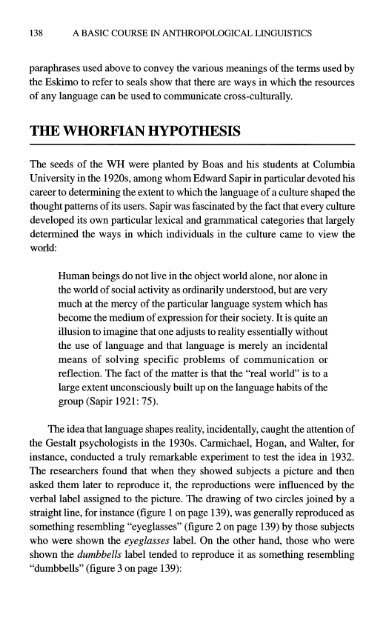A Basic Course in Anthropological Linguistics (Studies in Linguistic ...
A Basic Course in Anthropological Linguistics (Studies in Linguistic ...
A Basic Course in Anthropological Linguistics (Studies in Linguistic ...
Create successful ePaper yourself
Turn your PDF publications into a flip-book with our unique Google optimized e-Paper software.
138 A BASIC COURSE IN ANTHROPOLOGICAL LINGUISTICS<br />
paraphrases used above to convey the various mean<strong>in</strong>gs of the terms used by<br />
the Eskimo to refer to seals show that there are ways <strong>in</strong> which the resources<br />
of any language can be used to communicate cross-culturally.<br />
THE WHORFIAN HYPOTHESIS<br />
The seeds of the WH were planted by Boas and his students at Columbia<br />
University <strong>in</strong> the 1920s, among whom Edward Sapir <strong>in</strong> particular devoted his<br />
career to determ<strong>in</strong><strong>in</strong>g the extent to which the language of a culture shaped the<br />
thought patterns of its users. Sapir was fasc<strong>in</strong>ated by the fact that every culture<br />
developed its own particular lexical and grammatical categories that largely<br />
determ<strong>in</strong>ed the ways <strong>in</strong> which <strong>in</strong>dividuals <strong>in</strong> the culture came to view the<br />
world:<br />
Human be<strong>in</strong>gs do not live <strong>in</strong> the object world alone, nor alone <strong>in</strong><br />
the world of social activity as ord<strong>in</strong>arily understood, but are very<br />
much at the mercy of the particular language system which has<br />
become the medium of expression for their society. It is quite an<br />
illusion to imag<strong>in</strong>e that one adjusts to reality essentially without<br />
the use of language and that language is merely an <strong>in</strong>cidental<br />
means of solv<strong>in</strong>g specific problems of communication or<br />
reflection. The fact of the matter is that the “real world” is to a<br />
large extent unconsciously built up on the language habits of the<br />
group (Sapir 1921: 75).<br />
The idea that language shapes reality, <strong>in</strong>cidentally, caught the attention of<br />
the Gestalt psychologists <strong>in</strong> the 1930s. Carmichael, Hogan, and Walter, for<br />
<strong>in</strong>stance, conducted a truly remarkable experiment to test the idea <strong>in</strong> 1932.<br />
The researchers found that when they showed subjects a picture and then<br />
asked them later to reproduce it, the reproductions were <strong>in</strong>fluenced by the<br />
verbal label assigned to the picture. The draw<strong>in</strong>g of two circles jo<strong>in</strong>ed by a<br />
straight l<strong>in</strong>e, for <strong>in</strong>stance (figure 1 on page 139), was generally reproduced as<br />
someth<strong>in</strong>g resembl<strong>in</strong>g “eyeglasses” (figure 2 on page 139) by those subjects<br />
who were shown the eyeglasses label. On the other hand, those who were<br />
shown the dumbbells label tended to reproduce it as someth<strong>in</strong>g resembl<strong>in</strong>g<br />
“dumbbells” (figure 3 on page 139):






